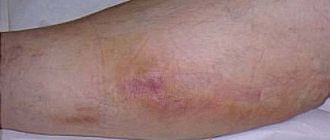Make an appointment Banal hemorrhoids can cause serious discomfort. Enlarged venous nodes in the rectum cause a sensation of the presence of a foreign body and bleed. According to statistics, the described problem plagues every fourth inhabitant of the planet. There is also a modern treatment method - disarterization of hemorrhoids, which does not require surgical intervention. A minimally invasive technique can completely eliminate the problem without causing severe discomfort to the patient. Removal of hemorrhoids can be done without surgery!
What kind of operation is disarterization?
Hemorrhoids are a disease that occurs against the background of inflammation, thrombosis and varicose veins of the hemorrhoidal veins. The inflammatory process leads to tortuosity of blood vessels and the formation of nodes around the rectum. If the disease progresses and no treatment is carried out, the nodes gradually reach large sizes and fall out of the rectum. Complications of hemorrhoids cause severe pain and limit the patient’s motor activity.
For hemorrhoids, disarterization surgery allows you to quickly remove hemorrhoids using a non-invasive method without radical surgery. The operation involves suture ligation or ligation of the inflamed artery, which is the main blood supply. The procedure is performed for both external and internal hemorrhoids.
The operation is performed only in a hospital setting, starting from the preparation period until the patient’s condition is completely stabilized. The main advantages include low trauma, short recovery period and minimal likelihood of relapse.
Pros and cons of disarterization of hemorrhoids
The procedure does not cause pain or severe discomfort. First, the proctologist injects the patient with local anesthesia. The doctor does not use a scalpel, the procedure takes a maximum of 40 minutes. Advantages of the technology and its variant HAR-RAR with mucopexy:
- Possibility of non-surgical removal of hemorrhoids.
- Unpleasant sensations during defecation disappear.
- Bleeding goes away.
- The vessels are securely fixed inside the rectum.
- No long-term rehabilitation or hospitalization is required.
- During manipulations, adjacent tissues are practically not damaged.
- The device accurately determines the depth of the vessels.
- One procedure is enough to solve the problem.
- After the operation, the patient returns to work within 1-3 days.
Desarterization of hemorrhoids with mucopexy is required if the node has descended beyond the rectum. In this case, the doctor cuts off the blood flow to the pathological area and pulls the sagging part to the anatomical bed. The HAL-RAR technique, which includes fixation and traction, is considered the most effective.
If disarterization of hemorrhoids is performed, complications are possible, and relapses occur. The procedure is contraindicated for pregnant women, people with mental disabilities, heart disease, and inflammatory processes. After the operation, the patient feels severe pain when going to the toilet. Bleeding is possible, it is necessary to take hemostatic agents and painkillers. It will take time for the discomfort to disappear.
The essence of the operation
Desarterization of hemorrhoids in Moscow is an innovative method of treating hemorrhoids, but reviews from patients who have already undergone treatment for the disease at the Yusupov Clinic confirm its safety and effectiveness.
The essence of the operation is to tighten the arteries that supply blood to the inflamed and tortuous vessels that form hemorrhoids. As a result, the nutrition of the pathological vessels stops, the inflammatory process stops, the nodes gradually decrease in size and dry out.
Up to six hemorrhoids can be blocked in one procedure. Desarterization of internal hemorrhoids, as well as external ones, is performed using local anesthesia. The surgical technique is determined individually. The procedure has contraindications, so preliminary diagnosis is mandatory.
Blog
Hemorrhoidal disease is a fairly common human disease. In the structure of visits to a proctologist, it occupies a leading place and accounts for about 40%. Many books and monographs, articles and scientific papers are devoted to the treatment of this disease.
Popov Vyacheslav Vladimirovich coloproctologist at the PERESVET clinic Read more
If 20 years ago the choice of treatment for a patient was not great and consisted only in the removal of hemorrhoids using the Milligan-Morgan hemorrhoidectomy method and its modifications, then recent years have been marked by the introduction of modern methods of treating chronic hemorrhoids of various degrees:
- Sclerotherapy
- Photocoagulation
- Ligation with latex rings
- Operation Longo
- Desarterization.
Each method has its own advantages and disadvantages.
I would like to devote this article to the surgical method of treating hemorrhoids by disarterization
and answer frequently asked questions from patients such as:
- Which treatment method for hemorrhoidal disease should I choose?
- Which method is the least traumatic?
- How long will I be unable to work?
- Which technique is the most radical?
- Are complications or relapses possible?
First of all, I would like to advise all patients not to look for methods and methods of treatment, but to choose a specialist who will help to understand everything. Often women express their desire to consult with a female doctor. Such a misconception does exist, but what is important here is not the gender of the specialist, but his experience and knowledge.
To date, based on ideas about the pathogenesis of hemorrhoidal disease, which in the early stages is based on dysfunction of the arterial inflow and venous outflow of blood, the method of disarterization of internal hemorrhoids (DIHA) is of greatest interest to science and practice.
Under epidural or intravenous anesthesia, a special device is inserted into the anal canal, which in its design has an ultrasound sensor, with its help the arteries feeding the hemorrhoidal tissue are identified. The proctologist ties each artery with a special thread, placing it so as to minimize the blood flow to the nodes.
The most protruding nodes, as a rule, are at 3,7, 11 o'clock, are stitched with a running stitch made from the base to the top of the node, the tissue of the hemorrhoid is compressed and lifted to its normal position. In this way, the functioning of the rectum is restored without incisions and scars.
Since the operation is aimed at getting rid of the cause of the disease, therefore it is highly effective and amounts to 96-97%, at stages 2-3 the most optimal result is achieved.
The disadvantages of the operation include the inability to eliminate external hemorrhoids, but this can be easily eliminated 3-5 months after the main stage. External hemorrhoids do not affect the quality of life, but are only a cosmetic defect. In a well-equipped clinic, a combination of disarterization and removal of external nodes at the same time is perhaps quite common, but this is done by prior agreement with the patient. Therefore, by resorting to this surgical treatment, you can fully rid yourself of this disease in 20-25 minutes! Yes, the duration of this operation, thanks to modern equipment and the experience of the surgeon, is such a short time.
This technique has virtually no contraindications and can be performed at any age. The duration of hospitalization is 1-2 days. If the postoperative period is smooth, patients can begin work within 2-3 days. The pain syndrome is minimal, easily relieved by non-steroidal anti-inflammatory drugs (analgin, ketorol, ibuprofen, nimesil), local treatment (anti-inflammatory suppositories, ointments, baths), phlebotonics (detralex, venarus, phlebodia 600).
What is needed to perform this operation?
- Stop being shy and afraid of this delicate problem.
- Pass a standard set of tests (general blood test, general urinalysis, biochemical blood test, coagulogram, blood group and Rh factor, ECG)
- do a cleansing enema (1.5-2 liters of water the evening before the operation and 2 hours before it) or purchase the laxative Microlax at the pharmacy (it is a syringe that is inserted into the rectum twice in the evening and 2 hours before the operation).
The article was written to familiarize patients with modern approaches to the treatment of hemorrhoidal disease.
Our clinic has all the capabilities to help you.
Coloproctologist Popov V.V.
Disarterization methods
For hemorrhoids, surgery is often recommended by healthcare providers. At the initial stage, conservative medicine can be used. However, a chronic disease can rarely be completely eliminated by treatment with tablets, ointments or suppositories. In most cases, patients periodically experience relapses, and when exposed to provoking factors, the disease begins to progress.
Minimally invasive hemorrhoid disarterization surgery is performed using three methods:
| Method | Description |
| Classical | Standard procedure for ligation of vascular sinuses at the base followed by bleeding of the nodes |
| Hal rar | An additional method of the classical technique with mucopexy (lifting and securing) of damaged soft tissues |
| With Doppler control | Technique of the operation using an ultrasonic sensor that identifies the artery associated with the sinus of pathological veins |
The minimally invasive technique allows you to carry out all the necessary manipulations without serious tissue injury. The process of blocking the blood supply to blood vessels is carried out using special instruments or a laser.
Advantages of the technique
Modern surgery has many advantages over classical surgical methods. The main advantage of disarterization of hemorrhoids is minimally invasiveness. Thanks to the gentle method of carrying out the procedure, it is possible to avoid complications, facilitate and shorten the rehabilitation period, and minimize the risk of re-development of hemorrhoids.
Other benefits of treating hemorrhoids with disarthriation:
- use of local anesthesia;
- The duration of the operation is no more than 30 minutes;
- absence of postoperative scars or scars;
- high efficiency;
- complete elimination of scars;
- rapid tissue regeneration;
- no side effects.
After disarterization of hemorrhoids, rehabilitation does not require a long period. A gentle surgical technique allows the patient to return to a full life without pain and suffering within 10-15 days.
Indications for disarterization
The main indication for disarterization is diagnosed hemorrhoids. The operation is performed during an inflammatory process affecting the venous sinuses with the subsequent development of internal and external hemorrhoids.
Desarterization is also effective for pathologies:
- thrombosis of rectal vessels;
- relapse after treatment;
- lack of effectiveness of conservative therapy.
The operation can be performed even if the nodes are small, if the disease has already become chronic. Before the procedure, the surgeon must conduct an examination and refer you for diagnostics.
Progress of the procedure
The procedure is often performed under spinal anesthesia. The patient is placed lying on his back, his legs are fixed in supports. The anal area and parts of the rectum are disinfected.
Next, a special anoscope with illumination and an ultrasound sensor is inserted, which responds to the pulsation of the vessel with an audio signal, which allows the doctor to accurately determine the location of the vessel.
Through a special side opening for manipulation, the artery is ligated with absorbable sutures. The same is done with other arteries supplying the node. The knot itself is stitched along its entire length with a single thread, its ends are pulled together and tied, which makes it possible to pull it towards the intestine, moving it away from the lumen.
At the end of the procedure, the wound area is disinfected and an anti-inflammatory tampon is inserted, which will come out on its own during bowel movements.
Contraindications for surgery
Even minimally invasive surgery can pose health risks to the patient due to certain body conditions or underlying diseases. To exclude complications before the procedure, the surgeon must conduct an examination and prescribe a diagnosis.
It is contraindicated to treat hemorrhoids using the disarterization method in the following pathologies:
- purulent processes occurring in the rectum;
- pararectal abscess;
- advanced stage of hemorrhoids;
- bleeding from the rectal opening;
- inflammation of tissue in the surgical area;
- severe condition of the body;
- blood clotting disorder.
The operation is not performed on pregnant women. It is recommended to get rid of hemorrhoids a few months after childbirth, when the body goes through the main stage of recovery.
Desarterization is not carried out during an exacerbation. Surgical intervention is possible after complete relief of severe symptoms and the onset of remission.
How to prepare for surgery
The main preparation consists of the patient undergoing an examination, which is prescribed by the doctor.
Before the operation, the patient undergoes an examination including:
- general blood test, biochemistry, Rh factor and group;
- analysis
- venous blood for hepatitis, HIV and a number of other diseases;
- electrocardiogram;
- fluorography.
If there are no contraindications to surgery, the doctor gives recommendations for preparation:
Compliance with the doctor’s recommendations will help to avoid difficulties during surgery and avoid complications in the postoperative period.
Performing disarterization
Treatment of hemorrhoids using the disarterization method is an absolutely painless operation. Local anesthesia is used to eliminate minimal pain. To exclude an allergic reaction and side effects in the postoperative period, the specialist individually selects a drug for pain relief.
Progress of the operation:
- performing a local anesthetic injection;
- insertion of an anoscope through the anus into the rectum;
- gaining access to the artery through the side opening of the anoscope;
- The surgeon isolates the blood vessel with a special instrument or laser;
- dressing is carried out with self-absorbing threads (when using a laser, no stitches are applied);
- All blood supply arteries associated with hemorrhoids are gradually blocked.
When performing disarterization using the Hal rar technique, during the operation the surgeon pulls the hemorrhoid inward and fixes it on the wall of the rectum. This method is suitable for internal vascular formations.
The average duration of surgery is about 30 minutes. In advanced cases, a longer procedure is possible.
Benefits of the procedure
Desarterization is one of the most popular medical procedures for the treatment of hemorrhoids. The operation is known for a number of advantages, including:
- Efficiency. The effect of the hal rar method appears immediately after the procedure. The bleeding stops, the hemorrhoids do not fall out, and their growth is stopped. The patient does not suffer from itching and burning in the anus. In addition, this procedure not only relieves the patient of pain, but eliminates the source of the disease and eliminates the cause of inflammation.
- Speed of the procedure. On average, the procedure lasts for an hour. The patient goes home on the same day. Conservative treatment continues.
- Comfortable carrying out. During disarterization, the patient is in medicated sleep, so there is no pain.
- Versatility. This treatment technique is called universal, since it is used in both the first and fourth stages of hemorrhoids. It is carried out even in the presence of fistulas and anal fissures.
- Safety. Desarterization has virtually no contraindications and is carried out for all age categories.
- Short-term rehabilitation. Rehabilitation is two weeks. Wounds heal quickly.
- No complications. In most cases, there are no complications after surgery. There are no scars or scars, as soft tissues are not damaged.
In addition, disarterization has a positive effect on reducing the flow of arterial blood to damaged vessels. Blood circulation in the veins improves. The size of internal and external hemorrhoids decreases.
Postoperative period
The rehabilitation period begins immediately after completion of the operation. Since surgery involves the circulatory system, the patient is under the supervision of qualified medical personnel for the first 3-4 hours after the procedure.
To relieve pain, which cannot be avoided since the operation is performed rectally, analgesics are taken. Severe pain subsides after a few hours. The unpleasant symptoms will completely disappear after 3 days. If there are no complications, then after eliminating the discomfort the patient can lead a normal life.
In order to speed up tissue recovery, the development of complications or relapse, surgeons advise in the first month:
- eat liquid food;
- stick to four meals a day;
- all meat products are prepared by stewing;
- consume fiber in the form of vegetables, fruits and berries (certain types) and protein and plant foods;
- exclude the intake of any products that can provoke irritation of the walls and mucous membrane of the gastrointestinal tract;
- exclude fried and fatty foods;
- do not drink alcohol and stop smoking;
- drink more fluids;
- do not do enemas;
- do not take a hot bath or use a sauna;
- take laxatives;
- exclude sexual intercourse.
The surgeon will prescribe the necessary medications and also explain how to treat the operated area.
Recovery after disarterization
The proctologist prescribes analgesic and painkillers to the patient to relieve pain. A personalized diet is prescribed. During the rehabilitation period, it is also worth excluding legumes, vegetables, baked goods, and exotic fruits, which can slow down bowel function.
It is worth rinsing the anal area with warm water after each bowel movement. This is necessary in order to prevent the development of infection. Apply antiseptic medications to the affected area twice a day. Hot water irritates the rectal mucosa.
It is strictly forbidden to have sexual activity for a month after the operation. Anal sex can lead to bleeding and anal fissures. It is necessary to exclude physical activity and ensure complete rest.
During rehabilitation, it is recommended to visit the proctologist several times to avoid postoperative complications. During this period, the patient takes laxatives and uses Vaseline oil. As a rule, there are no complications after disarterization, but if any complaints appear, you should immediately consult your doctor.
Treatment at the Yusupov Hospital
When treating hemorrhoids by blocking the arteries, the result largely depends on the professionalism of the surgeon.
Treatment of hemorrhoids in our hospital is a guarantee:
- high efficiency of the operation even at stage 4 of the disease;
- minimally invasive intervention ensuring minimal trauma;
- exclusion of complications;
- minimal risk of relapse;
- use of high-quality anesthetics;
- monitoring the patient’s condition until complete recovery;
- minimum recovery time.
Another significant advantage of performing disarterization of hemorrhoids at the Yusupov Hospital is the price. In our surgery clinic, the cost of disarterization of hemorrhoids depends on the surgical technique and the complexity of the clinical case. Treatment of hemorrhoids with desarterization is a way to quickly get rid of pain without complications or consequences.
Proctologists
Bagdasaryan Lev Karapetovich Surgeon - coloproctologist, candidate of medical sciences, doctor of the highest category, member of the Association of Coloproctologists of Russia.
Cost of admission 3500
₽
Make an appointment
Bagdasaryan Samvel Lvovich Surgeon - coloproctologist, candidate of medical sciences, member of the Association of Coloproctologists of Russia.
Cost of admission 2900
₽
Make an appointment











